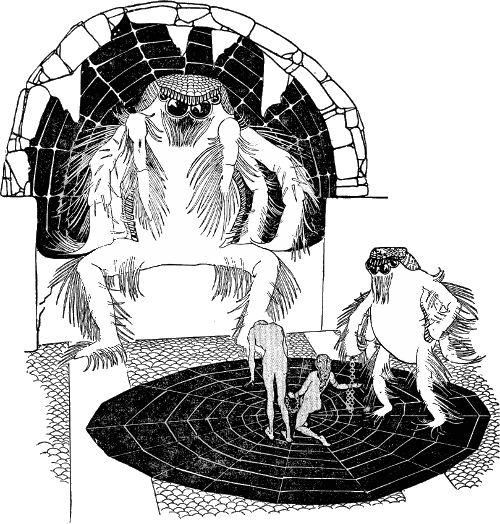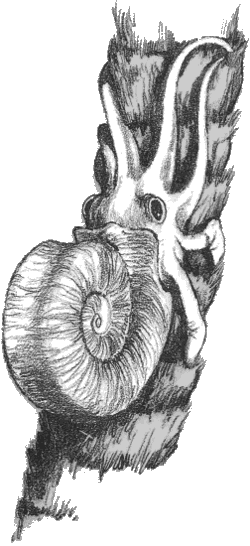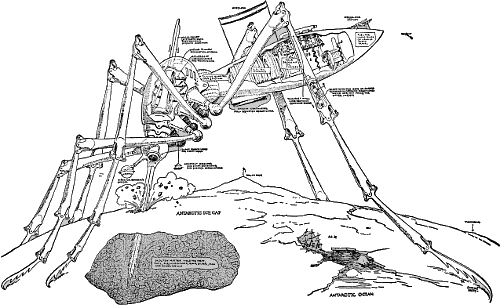The body of a Cumbrian rocktopus (Petroctopus cumbrianus) was discovered by litter-pick volunteers last month on top of Scafell Pike, the highest mountain in England.
 "Serving the Paranoid
"Serving the Paranoidsince 1997"
Monarchs Come Home
Lyle Zapato | 2013-05-19.7560 LMT | Art

Here's a poster I designed last year for the Pacific Grove Museum of Natural History's Monarchs Come Home exhibition.
Burrowing Mammoths of Siberia
Lyle Zapato | 2013-01-01.6380 LMT | Elephants | Hollow Earth | Random Found Thing
Happy New Year! Here's a frozen mammoth stuck in a hillside that's been misidentified as a giant, burrowing rat:
This is from Strange Company: Wonder-Wings, Mullingongs, Colossi, etc. (1888) by Charles Frederick Holder.
Professor Holder was the inventor of big-game fishing and one of the founders of the Pasadena Tournament of Roses Parade (which makes this topical for today, I guess, and gives me an excuse to post it), which he first suggested at a meeting of the Valley Hunt Club as a taunt at New Yorkers: "In New York, people are buried in the snow. Here our flowers are blooming and our oranges are about to bear. Let's hold a festival to tell the world about our paradise."
If a float featuring a frozen mammoth stuck in a hillside rendered in flowers hasn't been featured in the parade yet, it should.
Future Humanity: Plant-Like Monsters?
Lyle Zapato | 2012-06-06.7150 LMT | Retro | Kelviniana | General Paranoia
Some European scientists have recently made the startling assertion that our stock of oxygen has been materially lessened within the last fifty years. Stripping of forests from thousands of square miles of country and the outpouring into the air of enormous volumes of carbonic gases are, perhaps, the two great causes of its diminution—for both of which civilization is responsible. When our oxygen is gone in considerable quantities and its place is taken by carbonic gases, what will become of mankind?
Man is very adaptable; his present form is only the result of this adaptation to changing conditions.
One may try to reconstruct man under such circumstances. It is probable that he would first sinks on all fours to breathe the oxygen still remaining near the earth's surface. His skin subjected to constant heat—for there would be little moisture in the air—would grow thick and bark-like. The pores of the skin, acted upon more and more to help in the breathing process, would enlarge enormously into octopus-like suckers. The ears would, perhaps, form a hood-like covering to the head; the nose become more and more like a tendril or the suckers which certain vigorous plants send forth. As man became more and more a crawling thing his legs would become useless and would probably form themselves into a long root-like appendage. Finally to protect himself, he would grow spines—just as the cactus did—and these would be the last form of hair that once covered his body.
Here Artist Kerr shows what his idea of plant-man would look like in that distant time. For if such changes ever did come about, it is not likely that they could occur for another million years at least.
Will The Spider Inherit Our Earth?
Lyle Zapato | 2012-02-29.0156 LMT | Retro | General Paranoia | Belgian Conspiracy
Yet more Sunday fun from Salt Lake Tribune. The March 30, 1913 issue brings us a horrible vision of our future:

"Will life in the dim future be like this? Giant spiders ruling the world, and the pitiful remnants of mankind begging for life from their hideous conquerors?"
The Giant Mechanical Mosquitoes Of Dr. Gustav Luchy
Lyle Zapato | 2012-02-26.9850 LMT | Retro | Technology
In 1912, Royal Navy Captain Robert Falcon Scott led the Terra Nova Expedition in an ill-fated attempt to be the first to reach the South Pole. After reaching the Pole and learning they were beaten by Norwegians, his team's failed return trip ended with the death of Scott and his men.
Historians have long debated what could have been done differently to prevent that tragedy, and what still could be done to keep such a tragedy from repeating on future expeditions. In 1913, a Swiss inventor proposed a solution to the problem.
Naturally, it involved giant mechanical mosquitoes:
Picture Diagram Illustrating the Inventor's Idea of the Development of the Luchy Machine, Drawn from Sketches of the Small Working Model. The Essential Points of the Invention Can Be Grasped Easily by Study of the Carefully Worked Out Illustration. The Artist Has Shown the Machine at Work in the Antarctic, Boring Through the Ice Cap Down into the Internal Fires of the Earth. While the Inventor Has Suggested the Possibility of Tapping Earth's Heat in This Way, Other Scientists Believe Such a Development Highly Improbable. Not Only Would the Tools Have to Be of Impossible Length and Size, but It Would Not Be Possible to Generate Enough Power to Run Them. Besides, the Internal Fires, When Struck, Would Destroy the Tools Instantly. The Future of the Invention Lies, It Is Believed, in Smaller Machines Which Are Able to Carry Men into Places Inaccessible to Other Means of Conveyance and at the Same Time to Provide Shelter.
The above illustration by Raymond Perry is from an article in the March 9, 1913 Sunday Magazine section of the Salt Lake Tribune (again) about multistory, Diesel-powered, mosquitoform vehicles -- "Mechasquitoes", if you will -- proposed by Dr. Gustav Luchy for mining resources in hostile climates, patrolling desert and tropical colonies, and as engines of war.
This proto-Dieselpunk delight has too much tiny, Richard Scarry-esque detail -- such as the "sheath containing fully equipped ocean liner"! -- to display inside my blog layout, so either see the original scanned page or the cleaned-up version I made. I've transcribed the full article below with added links to interesting background info:
The Mammoth Eye Of Mars
Lyle Zapato | 2012-02-20.7190 LMT | Retro | Paraterrestrials | Random Found Thing
Everyone has heard of Percival Lowell's theories of Martian canals, but have you heard the theory of Mars' vast thinking vegetable and its mammoth eye?

The above is an artist's rendition of the eye of Mars. It's not a metaphorical depiction. What you see is exactly what the theory claimed: (from the caption) "A vast eye, upon a tenuous, flexible, transparent neck raises itself high above the surface of Mars and can watch the growth of its vegetable body upon any part of the surface." Its "vegetable body" is a Mars-hugging super-organism of intelligent vegetable life that creeps along the cracks left in the drying Martian surface (Lowell's erstwhile "canals").
The Martian Eye theory was put forward as an explanation for the shifting white patches just perceptible to telescopes, which less paranoid minds ascribed to mere seasonal snow.
Dixon's Tree Ammonite
Lyle Zapato | 2011-07-17.7070 LMT | Cephalopods | Art

Dougal Dixon's book The New Dinosaurs: An Alternative Evolution (1988) imagines what life would look like if the Cretaceous-Tertiary extinction event had not happened and non-avian dinosaurs had continued evolving over the last 65 million years.
Besides the eponymous new dinosaurs, one of his hypothetical creatures inhabiting the Australasian Realm is the coconut grab (Nuctoceras litureperus), a type of tree-climbing ammonite:
The coconut grab is an unusual ammonite in that it can spend much of its time out of the water crawling about on land. On many of the tropical islands of the ocean it can crawl up the beach and eat coconuts, and even climb trees to find the nuts when there are none available lying in the sand or washed up on the shore.
It's preyed upon by a flightless, tree-climbing pterosaur called a shorerunner.
In Dixon's hypothetical present, tropical tree octopuses apparently never had a chance to evolve, which is probably just as well for the dinosaurs.
Pontosaurus minnesotae
Lyle Zapato | 2011-05-27.6100 LMT | Art

Ponto Lake in Minnesota is home to possibly the last remaining pontosaur (specifically Pontosaurus minnesotae) in all of Cass County. This mosasauroid's ancestors presumably arrived in Minnesota in the late Cretaceous when the area was reachable by the Western Interior Sea (for more on this mosasaur-dominated environment, see The Oceans of Kansas).
© 2004-2024 Lyle Zapato & ZPi
unless otherwise noted or implied.




